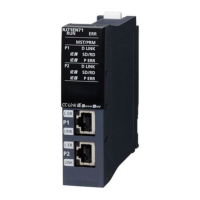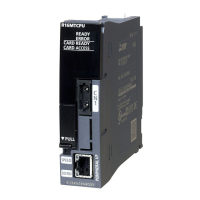2 PARAMETER SETTINGS
2.4 Application Settings
145
2
Communication Mode
Set the communication mode of the own station. Select the communication mode from "Normal", "High-Speed", or "High-
Speed Remote Net".
• In "High-Speed" mode, the maximum number of points assigned to RWw/RWr is 256 points per local
station.
• In "High-Speed" and "High-Speed Remote Net" mode, the priority of transient transmission is lower and its
processing speed is slower than in "Normal" mode.
• The "High-Speed Remote Net" mode can be set only for the master station.
• When "To Use or Not to Use the Safety Communication Setting" in "Application Settings" is set to "Use", the
"High-Speed Remote Net" mode cannot be selected.
• When "RJ71GF11-T2 (MR)", "RJ71GF11-T2 (SR)", or "RJ71GF11-T2 (LR)" is selected for the module
name, the "High-Speed Remote Net" mode cannot be selected.
• For RJ71EN71 and RnENCPU, when the "Port 1 Network Type" is set to "Ethernet" and "Port 2 Network
Type" is set to "CC-Link IE Field", the "High-Speed Remote Net" mode cannot be selected.
• When the "High-Speed Remote Net" mode is selected, the CC-Link IE Field Network communication unit
(GT15-J71GF13-T2) cannot be connected. Therefore, the GOT on which the CC-Link IE Field Network
communication unit (GT15-J71GF13-T2) is mounted cannot be connected.
• When "High-Speed Remote Net" is selected, the safety communication function cannot be used.
Parameter Name
Set a name for the module parameter if desired.
Dynamic Routing
Select whether to enable the dynamic routing function.
For details, refer to the following.
Page 36 Communications with different networks
Item Description Setting range
Communication Mode Normal
• Cyclic and transient transmission are performed without losing their
inherent speed performance. This mode is suitable for a system that
transmits large amount of data for management, monitoring, and
diagnostics by transient transmission along with I/O control or analog
control. ( Page 379 Differences in Cyclic Transmission Modes) Use
this mode for general application.
High-Speed
• Cyclic transmission has a priority over transient transmission. This mode is
suitable for applications requiring lower cycle times such as I/O control,
analog control, and digital I/O. ( Page 379 Differences in Cyclic
Transmission Modes)
High-Speed Remote Net
• This mode restricts the connectable station type to the intelligent device
station, remote device station, and remote I/O station and further speeds
up the link scan time of high-speed mode. This mode is effective when the
total number of stations or points of link device used in a network is large.
( Page 379 Differences in Cyclic Transmission Modes)
•Normal
• High-Speed
• High-Speed Remote Net
(Default: Normal)
Item Description Setting range
Parameter Name Set a name for the module parameter if desired. Up to 8 one-byte or two-byte characters
(Default: Blank)
Item Description Setting range
Dynamic Routing When communicating with different networks,
select whether to enable the dynamic routing
function.
• Enable
• Disable
(Default: Enable)

